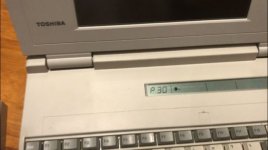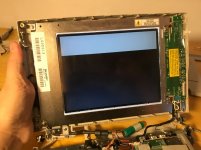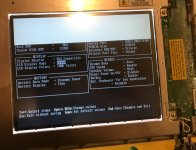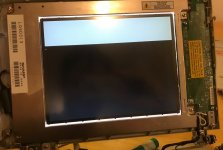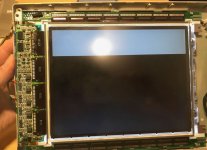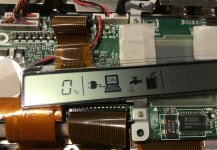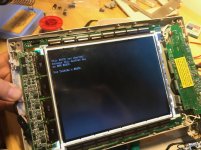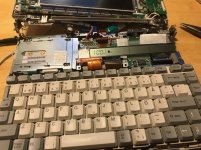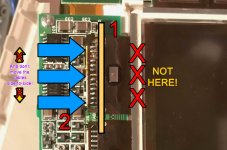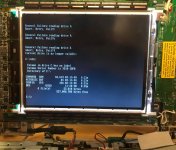VintageVic
Experienced Member
So,
I picked up another dead Toshiba from local auction site (for eur 19,- shipping included).
It's a T4500C with a dead battery and it won't start with the power charger either with battery unplugged.
Instead, the display shows a P30 error. Quick googling reveals, it is a "overvoltage" error. But the charger
seems to be ok, giving 15,16V with on load on it.
Cause might be dead caps at the power supply board. I listed all electrolytic caps there is (I already took the unit apart):
6,5V/1500uF (x2 units)
6,3V/1000uF (x1)
25V/470uF (x2)
16V/56uF (x2)
25V/33uF (x1)
I'm hunting cheap caps from ebay, since it'll take most likely 6 weeks to get all,
in the mean time I'm thinking if I could try to get some life by giving power to the board
from battery leads.
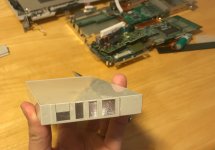
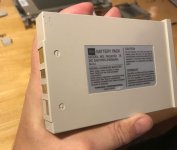
The battery is 9,6V, but there are 4 leads ? Does someone know the pinout for these ?
I'm not sure I have 9,6V psu, but maybe 9V / 10V I could find.
I tried the motherboard leads with multimeter after plugging the power supply on.
Let's read the contacts as A, B, C and D on the motherboard (A being negative, D being + on the motherboard).
When the power connector is plugged in, I'm getting zero voltage between A and D.
Since the battery is 9,6V, shouldn't this be also be 9,6V or slightly higher as the battery should be charged
from these pins ?
I'm getting 1,26V between A and B. And 4,86V between A and C contacts on the motherboard.
But, since I have no pinout, I can't imagine, what voltage these pins, B and C should have.
I picked up another dead Toshiba from local auction site (for eur 19,- shipping included).
It's a T4500C with a dead battery and it won't start with the power charger either with battery unplugged.
Instead, the display shows a P30 error. Quick googling reveals, it is a "overvoltage" error. But the charger
seems to be ok, giving 15,16V with on load on it.
Cause might be dead caps at the power supply board. I listed all electrolytic caps there is (I already took the unit apart):
6,5V/1500uF (x2 units)
6,3V/1000uF (x1)
25V/470uF (x2)
16V/56uF (x2)
25V/33uF (x1)
I'm hunting cheap caps from ebay, since it'll take most likely 6 weeks to get all,
in the mean time I'm thinking if I could try to get some life by giving power to the board
from battery leads.


The battery is 9,6V, but there are 4 leads ? Does someone know the pinout for these ?
I'm not sure I have 9,6V psu, but maybe 9V / 10V I could find.
I tried the motherboard leads with multimeter after plugging the power supply on.
Let's read the contacts as A, B, C and D on the motherboard (A being negative, D being + on the motherboard).
When the power connector is plugged in, I'm getting zero voltage between A and D.
Since the battery is 9,6V, shouldn't this be also be 9,6V or slightly higher as the battery should be charged
from these pins ?
I'm getting 1,26V between A and B. And 4,86V between A and C contacts on the motherboard.
But, since I have no pinout, I can't imagine, what voltage these pins, B and C should have.

